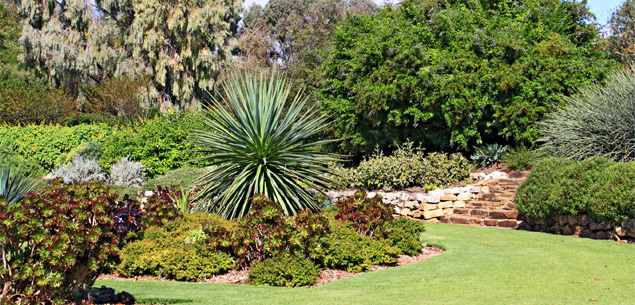It never occurred to me when I moved to the subtropical Far North that one day I would be wanting to plant a dry garden. The first three or four years I was here it rained for about nine months of the year, and the rest of the time it was so humid it may as well have been raining.
I was giving serious thought as to whether or not I was actually cut out for life in the subtropics when suddenly, it all changed. In 2010, it stopped raining in October and didn’t start again until May. I was in heaven. It didn’t last, of course.
This summer, it rained almost daily until two days after Christmas and The Partner was threatening to go back to Central Otago where, he said, it hardly ever rained. It is an indication of how depressing the weather had gotten that I was considering the idea, even though I become immobile when the temperature drops below 15°C.

Shells, stones, pavers and mulch create a sustainable environment where grasses are the mainstay plants.
Now it hasn’t rained for weeks and I am reminded that a reliable or even predictable climate, is probably a thing of the past. Gardening is changing and we will have to acquire new skills. Most important is learning to create gardens that will survive when it’s dry.
It might sound a bit desperate, but dry gardens can be gorgeous – striking, dramatic and different. They’re no longer about the succulents your grandmother grew, peeking out of a bed of pebbles, although the contemporary version of that has its place.
Instead, think long, delicate golden grasses pack-planted against a hot orange wall, robust agaves tumbling down a bank and enviably glossy fatshedera happily filling gaps with bright, stylish leaves.

The dryness of this slope has been accentuated with the use of rocks and plants in hot, desert-like colours.
If you have an established garden, now’s the time to catalogue which plants have done well without much water. In mine, viburnum, gardenia, hebe, abelia, vireya, grevillea and all the grasses have been standouts. The hibiscuses, which I expected would be yearning for water, have been stoic in the extreme, dear things.
So if you need to replace plants that have failed over summer, now is the time to plan a drought-resistant garden ready for planting in autumn. If you’re serious about working
towards drought tolerance, consider replacing some lawns and garden beds. Gravel, shells and pavers don’t need water and they can be the backbone of a spectacular dry garden.
Where you do want plants, start by adding heaps of compost to the soil to improve structure and nutrient levels. If your soil is clay, add grit and break it up so it doesn’t bake when it’s dry.
Lay damp newspapers on top and then mulch like mad to hang on to whatever water there is.

The Mediterranean and Central Otago come together with tussock and rosemary which both do well in the dry.
A dry garden needs just as much – if not more – planning than a standard area, because your choice of plants is limited. And if that’s discouraging, cast an eye to the Mediterranean – they don’t seem to have any problems creating fabulous gardens in the most inhospitable conditions.
WATERING
Even with water restrictions in place – your own or the council’s – there are ways to get moisture to your garden and keep it there.
Add a soil wetter such as Saturaid to improve water retention. Renew it in late spring each year, and add a wetting agent at planting time for plants that may be stressed by dry conditions.
Use mulches that will improve water retention such as compost, bark, pea-straw and gravel. Apply before the summer heat dries out the soil.
Conserve waste water from your washing machine and use it in the garden. It’s easy to divert the outflow into a barrel.
Even if you’re on a town water supply, collect water from spoutings on the house, garage and shed and pipe it into tanks to use in the garden.
It’s okay to use the hose (provided restrictions have not been imposed). Studies have found that hand-held hose watering is water-efficient.
Make watering an enjoyable part of your daily routine. Water at first light and enjoy the dawn chorus while you do so, it’s a lovely way to start the day. Take a sundowner out to the garden in the evening and water again while you review the day.
Hand watering is a good opportunity to check all your plants. Watch for those that have become loose in the dry soil – firm them in and stake if necessary.
Sweep, don’t hose. It may seem easier to hose those leaves off your path, but sweeping is cheaper and more sustainable.
Lastly, don’t despair. A new style of gardening will increase your knowledge and introduce you to a raft of plants you may not have met before. Remember that “xeriscaping” – dry climate gardening – doesn’t have to mean “zero-scaping”.

Bright, brash, cheerful and tolerant, the Aussie bottlebrushes are great dry-garden plants.
WHAT TO PLANT
New Zealand also has plenty of dry-garden plants and it’s an interesting challenge to figure out how to use them in contemporary garden designs. Cordylines, kowhai and puka are fantastic trees and form a great centrepiece for a dry garden, and some of our native grasses and tussocks perform well, too.
Consider coprosma, shrubs that come in a variety of colours with small flowers in spring, followed by berries. Corokia is another native evergreen with coloured foliage that varies from silver through to chocolate hues. Griselinia is a medium-sized tree with leathery leaves and tiny green and yellow flowers followed by small, purple-black fruit on the female tree.
Libertia, the New Zealand iris, provides all-year colour with bright leaves and white flowers in spring, followed by lasting golden seed pods. And what better reason to grow the Poor Knights Lily, with its fans of flax-like leaves and striking red flowers?

As with many droughttolerant plants, the narrow, greygreen leaves of the oleander are a clue that it’ll do all right in the dry. This garish pink is not the only colour choice.
In Australia, you’re spoiled for choice with eucalyptus, banksia, callistemon, acacia and grevillea. Many of the South Africans are also easy on water – check out proteas, leucospermums and leucodendrons. They’re sometimes frost-tender but great for milder dry climates.
Then there’s lavender, rosemary, olive, ceanothus, arctotis, cistus, cotoneaster, creeping zinnia, oleander, dracaena, agave, toetoe, euphorbia… take your pick.




